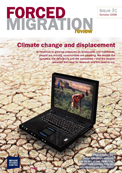Posted by Kayly Ober on December 24th, 2010 | 
Oxford’s Refugee Studies Centre shed some light on climate change and displacement from a local legal and policy framework perspective at a December 8 High Commissioner’s Dialogue side event. The Centre analyzed four countries that are particularly vulnerable to climate change-induced displacement: Bangladesh, Ghana, Kenya, and Bangladesh.
The study fills a significant lacuna. It assesses how legal protection frameworks might:
Although difficult to generalise from four case studies, the study provides a systematic review of the application and appropriateness of current frameworks, and how they might be adapted to this emerging category of migrants.
The case studies offer a cross-section of environmental conditions, internal and international displacement, slow-onset climate change scenarios – rising sea levels (Vietnam and Bangladesh) and desertification (Kenya and Ghana) – legal and normative rights protection apparatus, and governance structures.
The report finds that:
- Increasing internal political tensions created by environmental displacement reinforce the need to strengthen human rights protection;
- Protection for vulnerable groups before and after displacement, and in relation to slow-onset environmental displacement is significantly weak;
- Civil society actors are limited in playing an active role;
- Mixed migration flows and cross-border displacement are an increasing source of tension between governments, host communities and displaced persons;
- State-managed relocation policies to reduce vulnerability lack effective safeguards protecting the rights of relocated communities, are open to abuse and are rarely
transparent.
Read the report “Protecting environmentally displaced people: Developing the capacity of legal and normative frameworks” in full here.
Posted by Dan DaSilva on December 12th, 2010 | 
In case you missed it, the International Organization for Migration has recently released its annual World Migration Report 2010. The theme of the report is “The Future of Migration: Building Capacities for Change.” Part A covers capacity-building while Part B looks at trends in international migration.
IOM has also released an associated background paper on Climate Change and International Migration. It is one of 19 background papers which have been prepared for the World Migration Report.
This year, the World Youth Report 2010 focuses on youth and climate change, and is intended to highlight the important role young people play in addressing climate change. It features a chapter on migration and is worth having a look.
Dr. Jane McAdam has published an article in the forthcoming (2011) 23(1) International Journal of Refugee Law entitled “Swimming Against the Tide: Why a Climate Change Displacement Treaty is Not the Answer”. Drawing on field work in Tuvalu, Kiribati and Bangladesh, Dr Jane McAdam will argue that advocacy for a new treaty addressing climate-related movement is misplaced for a number of reasons.
Click here for the abstract and to read the entire article. Jane McAdam has also written an article for the Syndey Morning Herald titled “Number of climate refugees overstated”.
Finally, Reuters AlertNet has published a news article “Destitute climate migrants seen heaping pressure on neighbours”.
Below are some pictures from COP16 including the side event “Climate Change, Environment and Migration Alliance (CCEMA): understanding impacts and finding solutions”. This event was well attended, and covered issues such as migration as adaptation and rapid urbanization due to environmental migration.
We cannot display this gallery
Posted by Dan DaSilva on December 1st, 2010 | 
(Reuters AlertNet) November 29, 2010 – The unsolved puzzle of what to do with people forced from their homes by the effects of climate change – a hot topic a couple of years ago – seems to have slid down the agendas of aid agencies, policy makers and the media.
Maybe we’ve grown
tired of recycled guesstimates of the numbers likely to be displaced by more extreme weather and rising seas, and the seeming lack of political will to help them in a concrete way.
Most journalists covering climate issues will already have written one or two features about people fleeing encroaching oceans on low-lying Pacific Islands or unable to return to storm-battered villages on the Bangladesh coast. Are we running out of fresh ideas, and if so, why?
These days, many researchers are wary of forecasting climate-related displacement in the coming decades, aware that their methodology will be scrutinised and often found wanting. Meanwhile, efforts to craft national and international laws and policies to fill the yawning gap on climate migrants crawl along with few tangible results.
Continue reading this post »
Posted by Dan DaSilva on November 28th, 2010 | 

The United Nations Climate Change Conference starts tomorrow in Cancun and runs for two weeks. I am travelling right now where internet is limited so I will try my best keep the blog updated. I will be in Cancun during the second week to attend and cover a few of the related meetings. Below are some of the migration and displacement side events happening at COP16. If you know of any other events please contact me and I will add them to this post.
Displacement and migration: Examples of initiatives and activities to support resilience and adaptation
United Nations Population Fund (UNFPA)
Tuesday, November 30 – 18:30—20:00
This event will focus on national and sub-national level policy and programme implementation, including assistance in the development of policies on displacement and climate change; advocacy on displacement; and dissemination of tools that specifically target vulnerable communities such as refugees, internally displaced persons and migrants.
Climate change and forced migration (organized with Bread for the World and UNU)
Stockholm Environemntal Istitiute/IIED/IISD
Part of the “Development and Climate Days at COP-16”
Sunday, December 5 – Day Two – 1:30 pm – 3pm. By RSVP only.
– Chair: Koko Warner, UNU
– Ferdausur Rahman, Network on Climate Change in Bangladesh (NCCB)
– Peter Emberson, the Pacific Conference of Churches
– Isabel Cruz Hernández, Mexican Association of Credit Unions from the Social Sector
– Resettlement needs in Papua New Guinea, Sophia Wirshing, Bread for the World
– Africa presentation tbc
Rights for climate induced forced migrants : Responsibility of
international community
Coastal Association for Social Transformation Trust (COAST Trust)
Monday, December 6 -16:45—18:15
There will be 2 billion displaced people due to climate induced problems, alone in Bangladesh these figure will be 30 millions by
the year 2010, they should have rights to life and livelihood in view different UN convenants.
Climate Change, Environment and Migration Alliance (CCEMA): understanding impacts and finding solutions
International Organization for Migration (IOM)
Wednesday, December 8 – 15:00—16:30
IOM, UNU and other CCEMA partners highlight key questions and challenges for migration and displacement. Delegates and experts discuss proactive approaches for policy and practice in the context of climate change and adaptation, with relevant case studies.
Posted by Kayly Ober on November 23rd, 2010 | 
 Confronting Climate Displacement: Learning from Pakistan's Floods Refugees International released a report today on “Confronting Climate Displacement: Learning from Pakistan’s Floods“.
Read the executive summary below:
In July 2010, massive rain in Pakistan led to unprecedented flooding that submerged one-fifth of the country and affected more than 20 million people. While many experts believe the floods were the result of climate change, others say the science is uncertain. Regardless, most agree that natural disasters are occurring more frequently and that the international community is ill-equipped to respond. It is estimated that by 2050, as many as 200 million people will be displaced by natural disasters and climate change. The world’s poorest and most crisis-prone countries will be disproportionately affected.
This report explores what climate-induced displacement looks like and outlines steps to ensure that U.S. and international agencies address the threat that climate change poses to economic, political and human security. (See a full list of recommendations on page 20.) By evaluating and learning from the emergency response, the international community can implement more effective mechanisms and programs to prevent and respond to displacement from future natural disasters of this magnitude.
Continue reading this post »
Posted by Kayly Ober on November 18th, 2010 | 
(The Ecologist) November 11, 2010 – The causes of climate change are far from their shores, but these tiny Pacific nations face growing social strife and eventual annihilation unless western governments wake up and take responsibility, argue Scott Leckie and Dan Lewis.
Tessie Eria Lambourne’s bright smile belies a deeper sense of unease for which she as the secretary of Kiribati’s foreign ministry is responsible for imparting to the wider world. Lambourne is entrusted with no small task; she and her government face a choice no government should ever have to make. Fight or flight? The issues her government faces are both unprecedented and extraordinarily complex.
Ms Lambourne’s brief essentially entails nothing less than determining whether to fight for the very survival of her homeland or to pursue options overseas for the country’s threatened citizens. This is the new dilemma in a world where ever more people are facing the prospect that their homes and lands will be lost forever. Especially so in the case of atoll nations such as Kiribati and Tuvalu. The choice to battle the rising seas or set one’s families up in larger, distant nations is a very real one facing everyone in these two lands.
Ms Lambourne is not alone in her fight. Officials in nearby Tuvalu also grapple with the same questions. The unparalleled political wrangle of securing the best possible future for the entire populations of both countries, while watching rising seas from dwindling shorelines, is a mighty one.
Continue reading this post »
|
|





